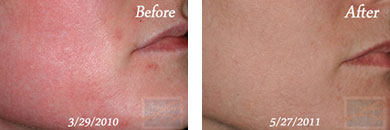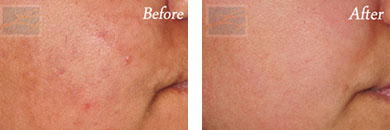A chemical peel is a way to gently resurface the skin by removing the top layers using a mild to moderate chemical solution as opposed to mechanical or heat resurfacing such as microdermabrasion or laser treatment. The laying down of new skin makes pores appear smaller, and can greatly diminish the appearance of fine lines, acne, and discoloration.
Ideal for the correction of several skin concerns, chemical peels are designed around each patient. Your experienced dermatologist will manipulate the various aspects of your treatment to produce the greatest effect. The variables of chemical peel treatment include the strength and type of acid used, and the amount of time an acid solution remains on the skin. Through precision planning and application, Dr. Lupo achieves beautiful results.
Chemical peels at Lupo Center for Aesthetic and General Dermatology
Chemical Peels have been around dermatology for decades. It remains a highly effective treatment for a variety of skin conditions, both medical and cosmetic.
What kind of chemicals are used in this procedure?
Some chemicals are extremely effective because they act as an anti-inflammatory agent to decrease rosacea and acne inflammation.
This would include salicylic acid and mandelic acid. Also, salicylic acid peels can be highly effective for melasma. We also use chemical peels, such as trichloroacetic acid, for photorejuvenation.
How safe are chemical peels?
Chemical peels remain one of the most popular and safe options for patients when performed by a board-certified dermatologist or plastic surgeon who understands the physiology of skin healing.
A chemical peel may produce virtually no flaking, or may require a few days of recovery based on the type and strength of the resurfacing solution. Standard glycolic peels tend to be quite mild, allowing the patient to resume normal activities while practicing adequate sun protection. Stronger peels will likely cause the skin to peel and flake for a few days, during which time it is even more important to stay out of the sun.
Dr. Mary Lupo has been treating the signs of aging for several years. In our office, we maximize the potential of chemical peel treatment by designing a suitable pre- and post-peel skin regimen before any treatment takes place. We may recommend Botox as a pre-treatment to chemical peels, so that treated skin heals smoother.
Post-treatment, it is important to keep the skin moist in order to prevent hyperpigmentation, infection, and redness. Sunscreen should be applied daily, and flaking skin should never be picked. Because optimal results are achieved by sun avoidance after treatment, the winter months may be the ideal time to schedule chemical peels at Lupo Center for Aesthetic and General Dermatology.
Performed properly by a highly trained professional, a chemical peel is safe and effective with little to no side effects. Contact our office today to schedule your skin rejuvenating treatment.
Dr. Lupo discusses the benefits of Chemical Peels
Dr. Mary Lupo
Lupo Center for Aesthetic and General Dermatology
In spite of all the lasers we have at the Lupo center, we still do some of the old fashioned things that work. We still do chemical peels! Chemical peeling is when a chemical is applied to the skin and at a certain depth it will remove certain layers of the skin. What we try to achieve with peeling is to gauge the depth of the peel to the need of the patient. If a patient is a very darker skin type we typically do more superficial or lighter peels that are safer with darker skin. We do a lot of peels for acne, not only does Salicylic acid improve the active acne, but it will improve the redness that can be residual after acne is healed as well as some of the pigmentation that is seen after acne. So chemical peeling whether it is superficial middle or deep is an option that is available here for our patients who prefer chemical peeling over laser treatments to improve their skin.
145 Robert E. Lee
Suite, 302
New Orleans, LA 70124
504-288-2381
www.DrMaryLupo.com


















